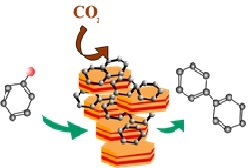Mohamed Mokhtar Mohamed Mostafa
King Abdulaziz University, Saudi Arabia
Title: Graphene oxide supported layered double hydroxide hybrids: Synthesis and applications
Biography
Biography: Mohamed Mokhtar Mohamed Mostafa
Abstract
Layered double hydroxides (LDHs) are class of two-dimensional (2D) anionic clays with brucite-like layered structure and intercalated anions. LDH materials can be converted to mixed metal oxides (MMO) nanocomposites after the thermal treatment. The MMO nanocomposites made from LDH precursors showed a uniform dispersion of metal ions as well as a high surface area in comparison to the metal oxides made by traditional chemical and physical method. Graphene oxide (GO) provides light-way, charge complementary, two-dimensional (2D) material that interacts effectively with 2D LDHs to form a hydride materials that improves the both the adsorption capacity of LDHs and their catalytic performance towards carbon-carbon coupling reaction. Recently, developing an efficient protocol for the synthesis of such materials was the interest of many researchers. Our group of research succeeded to synthesize a series of different LDHs /GO hybrids utilizing simple precipitation of LDH nanoparticles onto GO under controlled pH and temperature conditions. During the precipitation of positively charged LDH onto negatively charged GO, the mutual electrostatic interactions drive the self-assembly of hetero-structured nano-hybrids, in a “layer-by-layer” fashion. The CO2 adsorption capacity and multi-cycle stability of the LDH were both increased when supported onto GO because of enhanced particle dispersion. More recently, CuAl LDH/GO and CoAl LDH/GO hybrid materials with different LDH compositions were prepared. The as-synthesized hybrids and calcined composites were characterized by X-ray diffraction (XRD), scanning electron microscopy (SEM), thermal analysis (TG), Brunauer-Emmett-Teller (BET-surface area), temperature programmed reduction (TPR) measurements. CuAl- and CoAl-LDHs have shown excellent yields (91% and 98%, respectively) in 25 min. reaction times. However, the mechanical properties of GO allows an enhancement of the stability of the catalyst that can be separated and reused in the reaction several times with a loss of activity as low as 70% of its initial value after five cycles.

Recent Publications
- Xia Long, Zilong Wang, Shuang Xiao, Yiming An and Shihe Yang (2016) Materials Today: Transition metal based layered double hydroxides tailored for energy conversion and storage 19 (4):213-226.
- M. Mokhtar, A. Inayat, J. Ofili, W. Schwieger (2010) Appl. Clay Sci. Thermal decomposition, gas phase hydration and liquid phase reconstruction in the system Mg/Al hydrotalcite/mixed oxide: A comparative study 50: 176-181.
- Garcia Gallastegui, Ainara; Iruretagoyena, Diana; Gouvea, Veronica; Mokhtar, Mohamed; Asiri, Abdullah; Basahel, Sulaiman; Al-Thabaiti, Shaeel; Alyoubi, Abdulrahman; Chadwick, David; Shaffer, Milo (2012) Chem. Mater.: Graphene Oxide as support for Layered Double Hydroxides: enhancing the CO2 sorption capacity 24: 4531-4539
- Katabathini Narasimharao, Ebtisam Al-Sabban, Tamer Saleh, Ainara Garcia Gallastegui, , Almudena Celaya Sanfiz, Sulaiman Basahel, Shaeel Al-Thabaiti, Abdulrahman Alyoubi, Abdullah Obaid, Mohamed Mokhtar(2013) Mol. Cat. A: Chem.: Microwave assisted efficient protocol for the classic Ullmann homocoupling reaction using Cu-Mg-Al hydrotalcite catalysts 379: 152-162.
- Nesreen.S. Ahmed, Robert Menzel, Yifan Wang, Ainara Garcia-Gallastegui, Salem M. Bawaked, Abdullah Y. Obaid, Sulaiman N. Basahel, Mohamed Mokhtar (2016) J. Solid State Chem. Graphene-oxide-supported CuAl and CoAl layered double hydroxides as enhanced catalysts for carbon-carbon coupling via Ullmann reaction http://dx.doi.org/10.1016/j.jssc.2016.11.024

